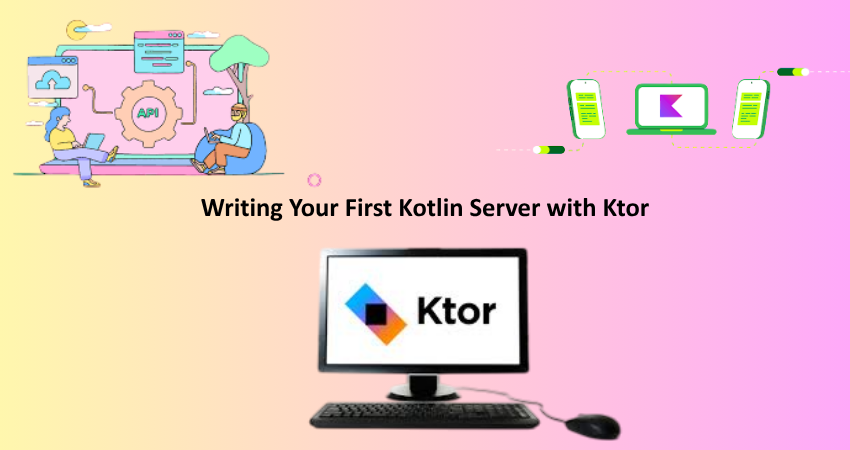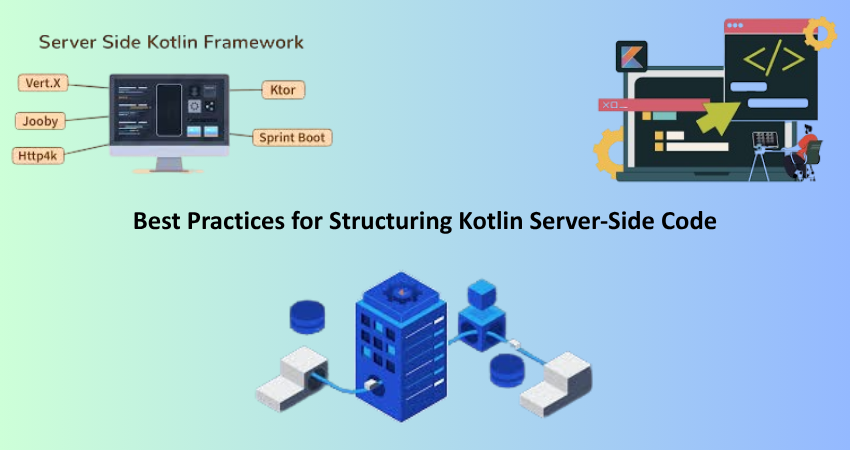
Introduction
Originally developed as JetBrains’ language, since it became quite popular for Android development, however, Kotlin developed very fast into a powerful server-side development language. It offers a modern, developer-friendly alternative to traditional back-end development with its expressive syntax, null safety, and seamless interoperability with Java. With the addition of official support from the major frameworks that matter-Django Boot and Ktor-Kotlin is now a strong contender to create REST APIs, microservices, and full-blown web applications. Its concise code and high-performance potential, combined with its growing ever-expanding ecosystem, create a strong competitor to other traditional JVM-based languages, namely Java and Scala.
Kotlin is ideally suited for developers and teams wishing to modernize their server-side stack or accept a cleaner syntax without sacrificing their existing Java infrastructure in the process; it incorporates everything required to reap all benefits of the JVM while almost doubling developer productivity and improving code quality. This guide takes you through everything an absolute newcomer into Kotlin for server-side development may want to know-from configuration to core language features to building that first server to favorite frameworks. If you’ve signed on for a Java backend but are looking for something new, Kotlin is excellent: it will refresh your mind and increase the efficiency with which you develop robust server-side applications.
Setting Up the Kotlin Development Environment
Installing Kotlin, IntelliJ IDEA, and Build Tools
To write Kotlin code for server applications, you need to have a setup environment ready. The best way to start is to install JDK (Java Development Kit) version above 11 or above to ensure excellent compatibility with modern frameworks like Spring Boot and Ktor. The Java Development Kit (JDK) is also needed to install an integrated development environment (IDE) that supports Kotlin since Kotlin runs on the Java Virtual Machine (JVM). The best kotlin development IDE is IntelliJ IDEA by JetBrains. It has excellent project creating/debugging/dependency management features.
After downloading IntelliJ IDEA, a simple Community Edition will do, you can create a new Kotlin project. It is intuitive in that it provides templates for Kotlin projects using Gradle or Maven, which are the two most widely used building tools for JVM-based server-side applications. Gradle is extensively chosen for Kotlin due to its flexible DSL and working along with Kotlin scripts. Also, it is handy to have a setup with the Kotlin command-line compiler, which can be installed with SDKMAN (for Unix-like systems) or downloaded from JetBrains’ website. This setup will ensure that you have a local environment for writing, compiling, and testing your Kotlin applications before deploying them to a cloud or production server.
Configuring Project Structure and Dependencies
After you have configured the development tools, the next step is to set up the project structures and dependencies. Stationery, the Kotlin project structure generally adheres to the standard JVM layout with normal src/main/kotlin for source files, src/test/kotlin for test cases, and resources. Project dependencies will be defined in the file build.gradle.kts using Kotlin DSL syntax, which contains all the information about the different libraries and tools with which your server-side application interacts. These libraries include Ktor for web routing, Exposed for database interaction, and Jackson for JSON serialization.
The following is an example of a simple Gradle build setup for a Kotlin server-side project:
kotlin
Copy
Edit
plugins {
kotlin(“jvm”) version “1.9.0”
application
}
repositories {
mavenCentral()
}
dependencies {
implementation(“io.ktor:ktor-server-core:2.3.0”)
implementation(“io.ktor:ktor-server-netty:2.3.0”)
implementation(“ch.qos.logback:logback-classic:1.2.11”)
testImplementation(kotlin(“test”))
}
application {
mainClass.set(“com.example.ApplicationKt”)
}
Such a setup allows you to quickly add dependencies and update dependencies with development as the project grows. Provided IntelliJ support for Gradle, the project automatically synchronizes any change in the build scripts. Now that it is done, one feels quite empowered on the first Kotlin server-side application with a very strong and extensible development foundation.
Writing Your First Kotlin Server with Ktor

Understanding the Basics of Ktor Framework
The Kotlin-saturated framework intended for an asynchronous server and web applications. Developed by JetBrains, Ktor combines Kotlin’s coroutines with DSL syntax to serve as a lighter and more flexible alternative to heavyweight Java frameworks like Spring. Modularity defines Ktor; you only use the features you need, leading to faster start-up times and smaller builds. REST APIs, WebSockets, and HTTP routing support the work of many modern server-side projects, especially microservices and APIs.
When Ktor is meant to be set up, the very first thing would be defining a main entry point that creates and starts an embedded Netty server. In between, routes, middlewares, and services for the application would be configured. Here comes a simple demonstration:
kotlin
Copy
Edit
fun main() {
embeddedServer(Netty, port = 8080) {
routing {
get(“/”) {
call.respondText(“Hello, Kotlin Server!”, ContentType.Text.Plain)
}
}
}.start(wait = true)
}
This simple setup opens a server that is set to port 8080 and returns a response in plain text when the root URL is accessed. The structure of Ktor is flexible and highly scalable, allowing for additional features like authentication, content negotiation, and access to databases when required. Ktor’s modularity really compliments the expressive syntax of Kotlin, making it an excellent option for those server-side programming developers who are truly entering the server-side arena or would be gradually porting their knowledge from Java to Kotlin.
Building Routing and Handling Requests
Building a server is just the first step; the next step involves defining advanced routes and handling all sorts of HTTP requests. Ktor’s routing system is really one of a declarative DSL which allows you to easily attach handlers on endpoints. Each of these handlers gets a call object by which all request and response lifecycle accesses can be made. You could extract parameters, parse query strings, read JSON payloads or get structured response objects back.
Here’s a sample route definition to handle the POST request with payload data in it.
routing {
post(“/submit”) {
val data = call.receive<Map<String, String>>()
call.respond(HttpStatusCode.Created, “Received: ${data[“name”]}”)
}
}
To make this function, one must install the right Ktor features such as ContentNegotiation and the Serialization with either Kotlinx or Jackson:
install(ContentNegotiation) {
json()
}
Routing can also be categorized based on paths or types of resources, which makes it enhanced to maintain in large applications. Middleware, called plugins in Ktor, can be installed for logging, error-handling, sessions, and security. You will go into Ktor’s architecture and discover how it really harmonizes and integrates with the type system in Kotlin since the writing of clean and safe code at the server level with complex flows of requests is not really discussed within the boilerplate.
Integrating with Databases and Services
Using Exposed ORM for Database Access
Interacting with the database is one of the most common requirements from the server side. For this purpose, Kotlin has various libraries, and Exposed is one of the most common libraries; it is an ORM or Object Relational Mapping library developed by JetBrains. Exposed implements both SQL DSL and DAO-style APIs, giving you added flexibility in your interaction with the database. On the other hand, a Kotlin-first design means that you have type safety, IntelliJ autocompletion, and compile-time checks—features that drastically reduce runtime errors.
To start the connection, first you will configure the database using a JDBC driver:
kotlin
Copy
Edit
Database.connect(
“jdbc:postgresql://localhost:5432/mydb”,
driver = “org.postgresql.Driver”,
user = “user”,
password = “password”
)
Afterward, you will define your tables with the help of Exposed DSL:
kotlin
Copy
Edit
object Users : Table() {
val id = integer(“id”).autoIncrement()
val name = varchar(“name”, 50)
val email = varchar(“email”, 255)
override val primaryKey = PrimaryKey(id)
}
CRUD operations will be handled through transaction blocks:
kotlin
Copy
Edit
transaction {
Users.insert {
it[name] = “John Doe”
it[email] = “john@example.com”
}
}
It makes query formulation simpler and decreases the likelihood of SQL injection attacks. For developers who have been using Hibernate or JPA frameworks, they can try Exposed as a lighter and healthier alternative and very much Kotlin-idiomatic. The application grows into a more complete application unit with Exposed put together with Flyway or Liquibase for migration administration with Ktor routes to provide complete stack Kotlin server applications relying on solid logic from the database.
Handling JSON and RESTful APIs
A common task for any server-side application is to communicate using JSON, particularly when following the RESTful architecture. This is made simple by Ktor with its rich serialization support. The built-in tools provided by the Kotlinx Serialization library allow for encoding and decoding of JSON to Kotlin data classes. To enable it, you need to install the ContentNegotiation plugin and configure the format in which you want to serialize:
kotlin
Copy
Edit
install(ContentNegotiation) {
json(Json {
prettyPrint = true
isLenient = true
ignoreUnknownKeys = true
})
}
Then, Kotlin data classes representing the specifics of request and response payloads are created:
kotlin
Copy
Edit
@Serializable
data class User(val name: String, val email: String)
Now, you can gather information from POST requests sent as JSON and respond back in JSON format:
kotlin
Copy
Edit
post(“/register”) {
val user = call.receive<User>()
// Process and store user
call.respond(HttpStatusCode.Created, user)
}
A clean and resilient coding experience is assured to you as Kotlin natively treats serialization. You should cash in on strong typing and compile-time-checking. This way, REST APIs can be implemented and developed in Kotlin code with high readability, security, and maintenance. Both of these database access abilities allow you to build a full server domain application while keeping external dependencies to a minimum and consistency in your codebase to the maximum extent possible.
Best Practices for Structuring Kotlin Server-Side Code

Separating Concerns with a Layered Architecture
Building a clean and modular architecture while developing scalable Kotlin server-side applications becomes a challenge. Normally, the layered architecture is used very often in backend development in Kotlin; this pattern divides the application into several layers, such as Presentation (Routing), Business Logic (Service), and Data Access (Repository/DAO). So this is how the complexity is well organized and also helps with the reusability of code and easy testing of units.
Modularity is even more enjoyed when working on a large project such that many employees can work on different portions of the system. For example, a backend engineer may write codes for improving database access without knowing how requests are routed. Similarly, a QA engineer can define unit tests directed towards the service layer. With Kotlin’s extension functions and top-level functions, you can also minimize boilerplate at each layer, thus creating clean and concise interfaces between components.
Using Dependency Injection for Better Testability
As server-side Kotlin projects increase, dependency handling across anything from services, through controllers, to repositories, is of growing importance. One best practice regarding the matter is the use of Dependency Injection (DI)—that is a pattern in which components do not themselves create their dependencies, but rather receive them from an external source. With regard to clean and testable dependency management, many Kotlin developers usually drop one or more Koin and Kodein, and maybe even Dagger, especially when they are coming from an Android background.
Additionally, dependency injection departs even further from the Single Responsibility Principle: the components no longer need to worry about how to acquire their own dependencies and can therefore concentrate on doing what they are actually supposed to do and trust the DI container for their needs. Thus, DI will obviously ease the growing pains of the system: if you want to replace a real database with some cloud-storage implementation, you only need to change the DI configuration file, and none of the business logic.
Conclusion
Kotlin has become an increasingly popular and favorable option for server-side development. Through its seamless Java interoperation, null safety, concise syntax, and coroutine support, Kotlin is effective as well as fun to use when building strong, scalable backend services. Combined with IntelliJ IDEA, Gradle, Ktor, and Exposed, it’s that kind of full-fledged ecosystem-simple to get on board with and powerful enough to use for enterprise applications.
For instance, being new and starting out with Kotlin for server-side projects, start by configuring a clean development environment, learn the language syntax, and then work around making your first server with Ktor. In the course of this learning phase, database integration and RESTful APIs will be pretty much done intuitively and productively. The language encourages fewer lines of code with fewer bugs, making it the perfect-fit language in a modern, agile workflow for backend development. Therefore, whether you come from Java or want to learn backend development from scratch, it will enable you to have the resources, scalability, and moral support necessary for the same in creating server-side applications for the future.